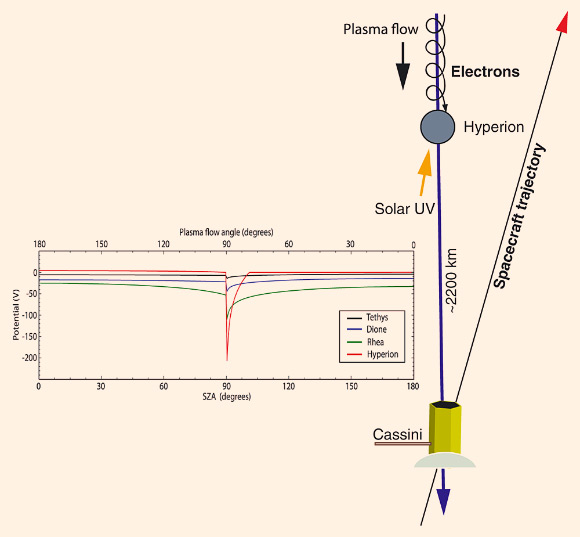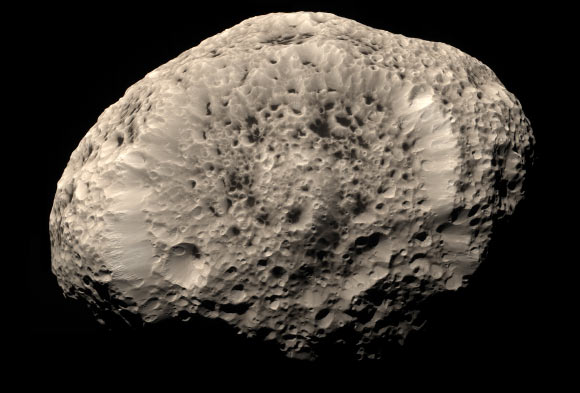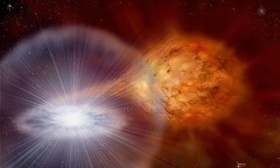On 26 September 2005, NASA/ESA Cassini spacecraft received the equivalent of a 200-volt electric shock from Hyperion’s electrostatically charged surface, even though the objects were over 2,000 km apart, says a team of scientists led by Tom Nordheim of University College London, UK. The finding represents the first confirmed detection of a charged surface on an object other than our Moon, although it is predicted to occur on many different bodies, including asteroids and comets.
Hyperion is an irregularly shaped outer moon of Saturn, with dimensions of 180 × 133 × 103 km and a mean radius of 133 km. It has a bizarre, sponge-like appearance owing to its unusually porous interior.
The only close flyby of Hyperion by the Cassini spacecraft occurred on 26 September 2005, when the spacecraft passed within 520 km of the moon’s surface.
Approximately 6 minutes before the closest approach, the Cassini Plasma Spectrometer on board the spacecraft detected a beam of electrons coming from the moon’s surface.
At the same time, Cassini’s Radio and Plasma Wave instrument detected intense plasma wave fluctuations caused by the electron beam.
The Cassini project team at the time realized that something odd was happening, but the evidence of Hyperion’s charging only became clear when Tom Nordheim and his colleagues revisited data from past flybys whilst studying the interaction between Saturn’s magnetosphere and its many icy moons.
Their study, published in the journal Geophysical Research Letters, reports that Cassini was briefly magnetically connected to the surface of Hyperion, allowing it to be caught by a beam of negatively charged particles coming from the moon’s electrostatically charged surface.

Left: predicted surface potential versus solar zenith angle for Hyperion (red), and for Tethys, Dione, and Rhea, for comparison. Right: Cassini orbiter remotely detected a strongly negative surface potential (minus 200 volts) on Hyperion, consistent with the predicted electrostatic charge in regions near the moon’s terminator – the day-night boundary. Image credit: T. A. Nordheim et al.
Static electricity is known to play an important role on Earth’s airless, dusty Moon, but evidence of surface charging on other objects in the Solar System has been elusive until now.
“The surface of Hyperion becomes charged when exposed to ultraviolet light from the Sun and plasma, which contains charged particles, in Saturn’s magnetosphere – the invisible, movable bubble generated by the planet’s internal magnetic field,” Tom Nordheim explained.
“The large difference in potential between the surface and the spacecraft resulted in a flow of electrons being accelerated from Hyperion toward Cassini,” he added.
“It was rather like Cassini receiving a 200-volt electric shock from Hyperion, even though they were over 2,000 km apart at the time. The alignment between the two was just right for us to be able to detect this fairly rare event. If Cassini had been in a different location during the flyby, the electron beam would not have been detected.”
Although Cassini mission controllers have detected no signs that the Hyperion electron beam caused damage to the spacecraft, strong electric charging effects could prove to be a hazard to future robotic and human explorers at planetary objects without atmospheres, where they could create the potential for powerful electrostatic discharges.
Source: http://www.sci-news.com
“The surface of Hyperion becomes charged when exposed to ultraviolet light from the Sun and plasma, which contains charged particles, in Saturn’s magnetosphere – the invisible, movable bubble generated by the planet’s internal magnetic field,” Tom Nordheim explained.
“The large difference in potential between the surface and the spacecraft resulted in a flow of electrons being accelerated from Hyperion toward Cassini,” he added.
“It was rather like Cassini receiving a 200-volt electric shock from Hyperion, even though they were over 2,000 km apart at the time. The alignment between the two was just right for us to be able to detect this fairly rare event. If Cassini had been in a different location during the flyby, the electron beam would not have been detected.”
Although Cassini mission controllers have detected no signs that the Hyperion electron beam caused damage to the spacecraft, strong electric charging effects could prove to be a hazard to future robotic and human explorers at planetary objects without atmospheres, where they could create the potential for powerful electrostatic discharges.
Source: http://www.sci-news.com






 RSS Feed
RSS Feed